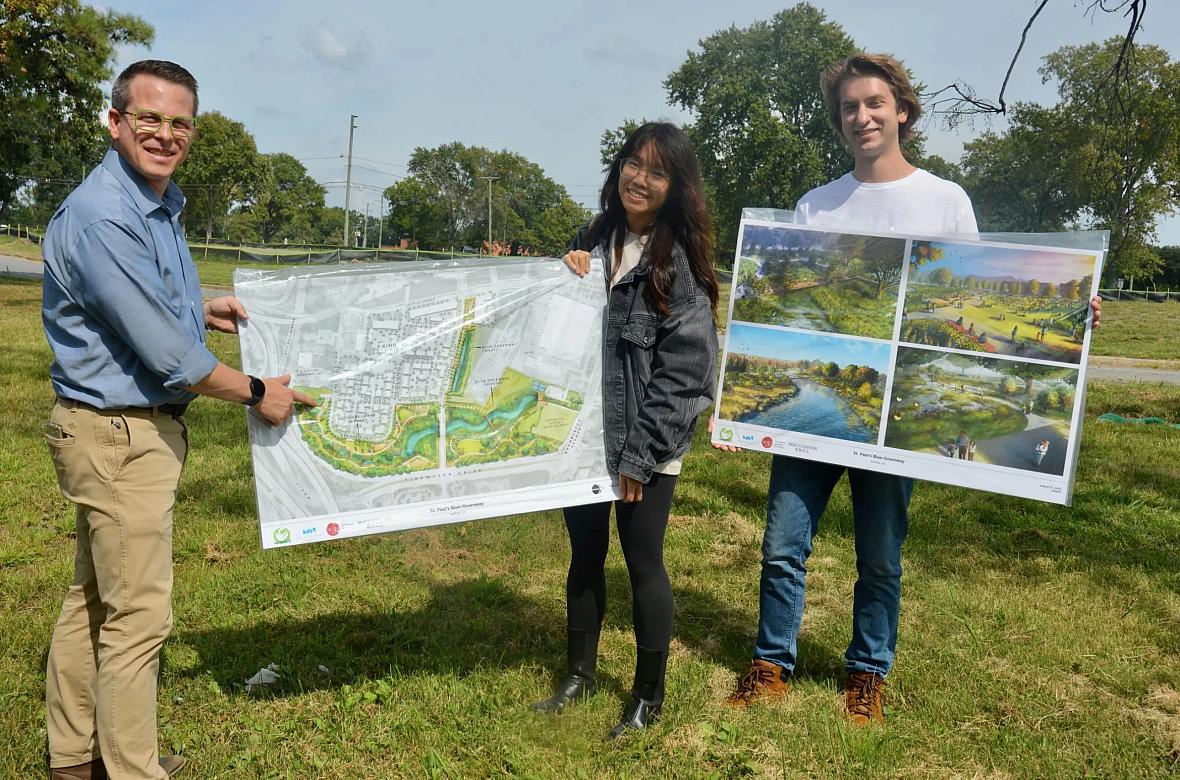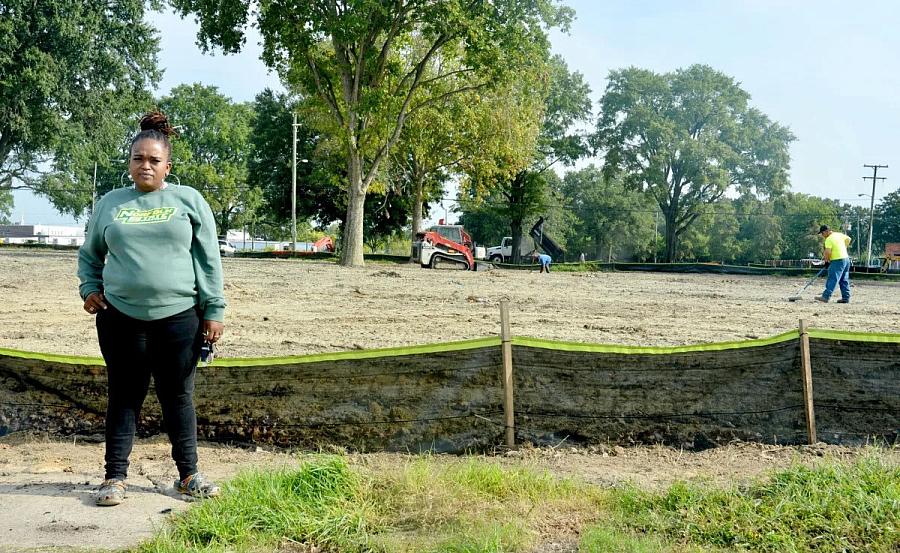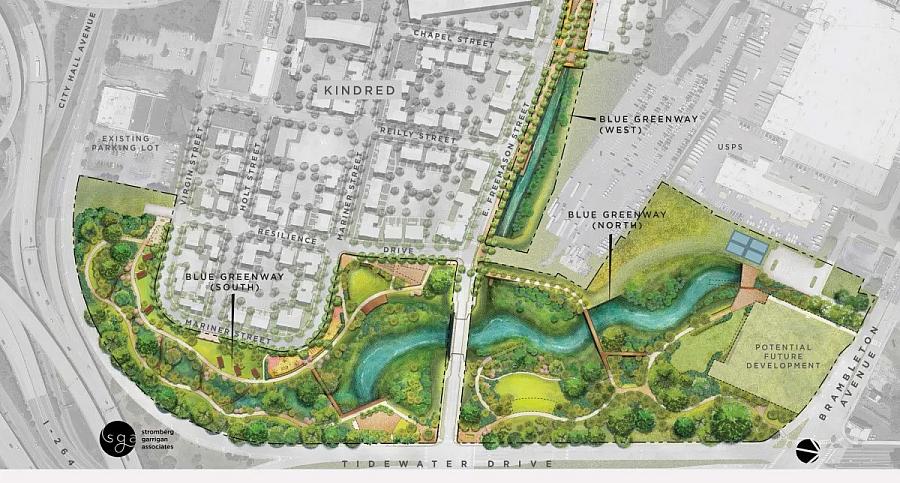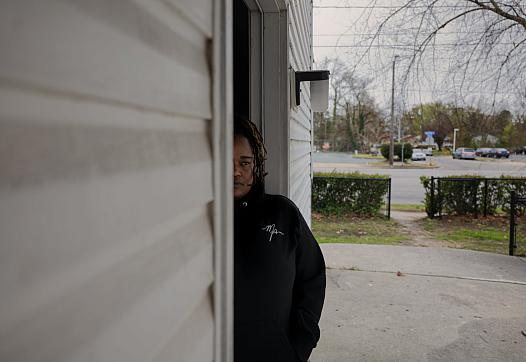Climate resilience project aims to reimagine neglected, flood-prone Norfolk neighborhood
This story was originally published by Energy News Network with support from our 2023 National Fellowship.

Tim Stromberg, Yuehui Gong and Alex White share visions for the Blue Greenway.
Elizabeth McGowan / Energy News Network
NORFOLK, Va. — Rainstorms at Tidewater Gardens public housing complex were anxiety-inducing enough. That dread among parents was only amplified when the skies opened up on schooldays.
Fast-pooling water would convert the low-lying community along the Elizabeth River floodplain into a soupy mess that trapped cars and made flippers a more fitting footwear choice than rubber boots.
“If it rained for just 10 minutes straight, it was flooded and you were stuck,” said Zenobia Wilson, a mother of three and resident of the public housing complex for 12 years. “We had to carry our children on our backs to get them to and from school.
“It was beyond boots because the water was up to our knees, every time.”

Zenobia Wilson stands on the site of the razed Tidewater Gardens apartments.
Elizabeth McGowan / Energy News Network
Norfolk is on the cusp of acting to tame the torrents that regularly saturated a marginalized neighborhood as climate change-induced rainfall intensifies.
Their proposed remedy is a massive endeavor to reshape both land use and water flow as the city of 233,000 plugs away at its ambitious St. Paul’s Transformation Project.
What’s called the Blue Greenway is the environmental centerpiece of the first phase of a hotly debated, $400 million undertaking to reinvent the housing, layout and vibe of a poor, majority Black community along the city’s neglected east-side waterfront.
Ideally, the linear park still in the design stage will blend the practical with the pretty to fabricate a linear 23-acre resource to capture storm water runoff, welcome back a slice of the natural world and appeal to picnickers and outdoor exercisers deprived of green spaces for decades.
Construction likely won’t begin until next spring, but landscape architect Tim Stromberg has been huddling with a team of engineers, environmental scientists, architects and other specialists for several years. They’re striving to turn a liability — stormwater runoff — into an asset.
“This area is a park desert,” said the 45-year-old principal with Norfolk-based Stromberg/Garrigan & Associates. “We see this as a health and wellness project.”
Most of the Blue Greenway will flow through the broad footprint of what was Tidewater Gardens, built in the early 1950s atop a tidal creek and a radiating network of wetlands.
The last of the red brick, barracks style apartments — where residents tangled regularly with leaks and mold infestations — was demolished in August 2023. The nearby Tidewater Park Elementary School, where parents dropped off their children, is shuttered and set to be torn down.
Just feet from the school, along bustling East Brambleton Avenue, crews will eventually “daylight” Newton’s Creek, constricted to an underground culvert for decades. That liquid spine of the Blue Greenway will wind its way south to the center of a pillar of east Norfolk’s Black community, the Basilica of St. Mary of the Immaculate Conception.

Courtesy / Stomberg/Garrigan & Associates
Roughly three acres of newly constructed wetlands and the primary water channel — about the length of four football fields and up to 130 feet wide — will be the workhorses of the engineered project. They will play a gigantic role in filtering pollutants from absorbed runoff before it empties into the Elizabeth River and then the Chesapeake Bay.
Its price tag of up to $60 million will be covered with city dollars and federal grants.
Basically, it will resemble an elongated bathtub that is 8 to 9 feet deep. Its wide, encircling rim is designed as a necklace of green space dotted with amenities.
Norfolk’s extreme climate crisis
Norfolk, part of Virginia’s expansive Tidewater region, is trying to address warming of the planet on multiple fronts because of the well-documented double-whammy effect of climate change.
Not only are deluges more intense, but sea levels are rising faster here than anywhere else on the East Coast. The latter is exacerbated by a phenomenon called subsidence. Simply put, coastal lands are sinking because communities are withdrawing — and not replenishing — enormous quantities of groundwater.
On a separate but complementary climate front, the city is in the midst of advancing a gargantuan floodwall endeavor made up of tide gates, levees, pump stations and natural features such as oyster reefs and native vegetation along the shoreline. The federal government is covering 65% of the $2.6 billion project specifically designed to protect Norfolk from catastrophic storms. State and local funds are supposed to cover the remainder.
Preventing flooding is just one of the Greenway’s climate and health benefits. It also can clean the air and mitigate the urban heat island effect, which is especially harsh in congested cities where concentrations of asphalt and concrete raise temperatures to dangerous highs.
“Climate change is about adaptation,” Stromberg said about incorporating the Blue Greenway into a reimagined neighborhood. “That made us think about the scenarios of today and of the future.”
Once it’s built, “maintaining this will require five or six city departments,” Stromberg said. “This could serve as a model for how to repurpose a piece of land for a higher and better use.”
Landscape architects, he explained, tie the built and urban environments to natural systems.
“Creating something like this is a landscape architect’s dream,” Stromberg said about SGA’s largest project to date. “The reward when it’s built will be to see people using the space.”
After all, the handprints of former Tidewater Gardens residents are all over the Greenway’s blueprints.
‘Listening is so crucial’
While Stromberg’s team is handling the park’s technical infrastructure elements, they relied on input about amenities from Tidewater Gardens residents who called the 618-unit complex home until they were relocated two years ago.
“Listening is so crucial,” Stromberg said, about the joint brainstorming sessions that began in 2019. “We wanted to make sure we were extremely sensitive to the community’s needs.”

Courtesy / Stomberg/Garrigan & Associates
Preserving and protecting the canopy of thirsty and mature oaks, magnolias and other trees that once shaded the apartments was paramount for residents. They also wanted pavilions added for reunions, parties and cookouts.
Yet another request centered on access to walking paths, fitness equipment, a splash park, playgrounds, basketball courts, and lessons about birds, butterflies and native plants.
“These are simple requests and we want to honor them,” Stromberg said. “This is about giving people access to something they cherish.”
Greenway plans call for planting at least 300 trees, 5,000 shrubs and 200,000 grasses and flowers.
Balancing man-made and natural systems serves as a welcome mat for inclusivity, said Mike Fox, Stromberg’s colleague.
“With the wetlands come the butterflies and frogs and crickets,” Fox said. “That whole experience, being part of nature is what’s therapeutic and adds to visitors’ serenity.”
Who will benefit?
Stromberg is counting on the unique oasis to be a neighborhood magnet. He noted that it can be extended north of East Brambleton Avenue, near the former elementary school.
That expansion idea remains in the mix as Norfolk plans to eventually raze and reinvent two other nearby public housing complexes shortchanged on parks — Young Terrace and Calvert Square — in the next phases of the St. Paul’s transformation.
Also, the Blue Greenway will be at the centerpiece of a related city scheme to link the St. Paul’s neighborhood to the previously inaccessible Elizabeth River Trail, the expansive downtown waterfront and Norfolk’s more affluent west side.
For 60-plus years, the community has been isolated by loud, pedestrian-unfriendly, heavily trafficked roads and a tangle of on- and off-ramps, cloverleaf interchanges and overpasses feeding Interstate 264.
City officials are studying how to tackle a large-scale roadway makeover courtesy of a federal grant designed to heal past injustices inflicted on Black communities nationwide.
Tensions have festered about who will actually benefit from such wholesale changes.
For instance, activists with the New Virginia Majority accused the city of “saving the trees, not the people” with its Blue Greenway project. In tandem, they claim wealthier newcomers, not displaced former residents, will eventually become the majority in mixed-use housing being built near the site of Tidewater Gardens. To help prevent flooding, the new housing is being built on ground that has been elevated with at least seven feet of soil.

Renderings of housing proposed for the St. Paul’s Transformation Project.
Work Program Architects
Stromberg is tuned in to how complicated and difficult these transitions are for cities. As the planet warms, they’re an even trickier balancing act for leaders trying to meet the needs of residents while also accounting for racist policies of the past.
“The jury is still out on what the success rate will be for the return of former Tidewater Gardens’ residents,” he said, adding he’s hoping the Blue Greenway will serve as a lure.
“As some start to move back, I can see a second wave of former residents reconnecting to their neighborhood,” he said. “The key is that they have a sense of ownership.”
Susan Perry, director of the city’s Department of Housing and Community Development since 2021, has focused on resilience and alleviating poverty in her decade-plus career with local government.
Norfolk would have been remiss with this redevelopment project, she said, if it had stopped at simply replacing deteriorating housing and re-establishing a street grid to tether the neighborhood to downtown amenities.
The impact of soaring emissions of heat-trapping gases couldn’t be ignored.
“What we always say is that the Blue Greenway is our resilience strategy writ large,” Perry said. “It really will be a crown jewel of the neighborhood.”

